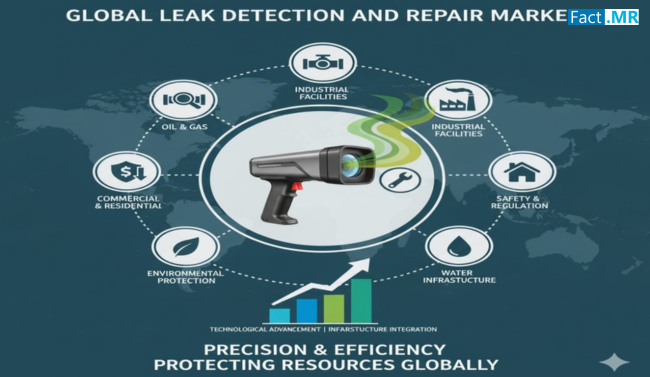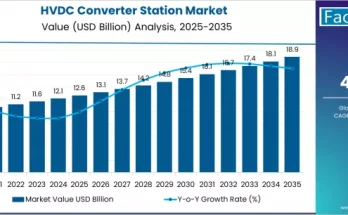Industries worldwide are under increasing pressure to maintain operational safety, reduce emissions, and comply with stringent environmental regulations. The leak detection and repair (LDAR) market has emerged as a crucial solution to address these challenges. LDAR programs focus on identifying and repairing leaks in industrial facilities, preventing the release of volatile organic compounds (VOCs) and other hazardous gases. By ensuring accurate monitoring and timely repairs, LDAR systems help businesses reduce environmental impact, enhance workplace safety, and minimize operational losses.
Market Overview
Leak detection and repair involves systematic monitoring of pipelines, valves, pumps, and storage tanks to identify leaks and carry out corrective measures. Advanced LDAR technologies, such as optical gas imaging, infrared spectroscopy, ultrasonic testing, and continuous sensor monitoring, allow industries to detect leaks quickly and accurately.
Modern LDAR programs integrate real-time data monitoring, automated reporting, and maintenance tracking, enhancing operational efficiency. These solutions are widely deployed across oil and gas, chemical manufacturing, pharmaceuticals, energy utilities, and other industries where precise gas handling is critical. By minimizing fugitive emissions, LDAR programs support environmental compliance and align with corporate sustainability initiatives.
Regional Insights
Regional adoption of LDAR programs is influenced by regulatory frameworks and industrial growth.
- North America leads in adoption due to strict environmental regulations and mature industrial infrastructure. Compliance with EPA standards drives the use of advanced leak detection technologies.
- Europe follows closely, supported by EU directives and sustainability mandates. Chemical and energy sectors are major consumers of LDAR solutions.
- Asia-Pacific is a fast-growing market, driven by expanding industrialization and regulatory enforcement. Emerging economies are investing in LDAR systems to improve safety and operational efficiency.
- Middle East & Africa and Latin America are gradually adopting LDAR programs, particularly in oil and gas sectors, as environmental awareness increases.
Key Trends
- Technological Advancements
New LDAR technologies, including optical gas imaging and laser-based detection, provide higher sensitivity and faster detection of leaks. Continuous monitoring systems and real-time data analytics are enhancing overall efficiency. - Digital Integration and IoT
IoT-enabled LDAR solutions allow remote monitoring, predictive maintenance, and automated reporting. Digital platforms help industries optimize inspection schedules and improve compliance management. - Sustainability and ESG Focus
With rising environmental concerns and corporate responsibility standards, LDAR adoption helps organizations reduce emissions, meet ESG targets, and strengthen brand reputation. - Cost and Efficiency Benefits
Timely detection and repair of leaks prevent product loss, reduce energy consumption, and lower the risk of environmental penalties, making LDAR systems economically advantageous. - Expansion of LDAR Services
Third-party providers are offering comprehensive LDAR solutions, including inspection, monitoring, and repair services. Outsourcing LDAR ensures regulatory compliance and reduces the burden on internal resources.
Applications and End-Use
LDAR programs are critical across multiple industries:
- Oil and Gas: Monitoring pipelines, refineries, and storage tanks to prevent hydrocarbon leaks.
- Chemical and Petrochemical: Managing emissions of hazardous compounds while maintaining safety standards.
- Pharmaceuticals: Ensuring precise moisture- and gas-sensitive processes meet safety and quality regulations.
- Manufacturing: Detecting leaks in production lines and equipment to minimize emissions and operational risk.
- Utilities and Energy: Maintaining safety and efficiency in fuel handling and gas systems.
Market Drivers
- Regulatory Compliance: Industries must adhere to stringent emission standards to avoid fines and reputational damage.
- Safety Concerns: Leak prevention is vital for reducing accidents and protecting employees and the environment.
- Industrial Growth: Expanding manufacturing, energy, and chemical operations increase demand for LDAR systems.
- Technological Innovation: Integration of smart sensors, AI, and predictive analytics enhances inspection efficiency.
- Environmental Responsibility: Corporations are investing in LDAR programs to achieve sustainability goals and reduce carbon footprints.
Challenges
- High Initial Investment: Advanced LDAR technologies and skilled personnel requirements can be costly.
- Technical Complexity: Accurate operation and data interpretation require trained professionals.
- Maintenance Needs: Regular calibration and servicing are essential to maintain precision.
- Integration with Legacy Systems: Retrofitting LDAR solutions into older facilities can be challenging.
Competitive Landscape
The LDAR market is competitive, with manufacturers and service providers differentiating through technology, service quality, and compliance expertise. Strategies include:
- Development of high-accuracy, real-time detection technologies
- Offering complete LDAR service packages with inspection, repair, and reporting
- Expansion into emerging markets with cost-effective solutions
- Integration with digital platforms for IoT-based monitoring and predictive maintenance
Partnerships with industrial players, energy companies, and environmental agencies are helping companies expand their reach and offer end-to-end solutions.
Future Outlook
The LDAR market is expected to grow steadily, driven by global environmental regulations, industrial automation, and sustainability initiatives. Emerging technologies, including IoT-enabled systems, digital twins, and AI-based analytics, will enhance predictive maintenance and operational efficiency. Expansion into emerging economies and industries with rising environmental awareness will further drive adoption.
Industries increasingly recognize that investing in LDAR programs is not just a compliance measure but a strategic move to reduce emissions, prevent accidents, and improve operational profitability.
Conclusion
The leak detection and repair market plays a pivotal role in industrial safety, environmental compliance, and operational efficiency. Advanced LDAR solutions, supported by smart monitoring, digital integration, and precise detection technologies, help industries minimize emissions, reduce product loss, and maintain regulatory standards.
As sustainability and environmental responsibility become central to corporate strategy, LDAR programs are poised to become a standard practice across oil and gas, chemical, manufacturing, and energy sectors. Organizations that adopt advanced leak detection and repair solutions are not only ensuring compliance but also enhancing operational efficiency and supporting long-term sustainability goals.



